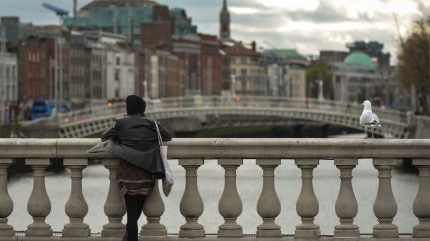
Ireland has been a rising foreign direct investment star in recent years, and since 2016 it has taken a number of financial services projects away from a Brexit-bound UK. Its largest city and capital, Dublin, is the country’s economic centre, but what of the rest of the top five, namely Cork, Limerick, Galway and Waterford?
1. Dublin
Population: 1.17 million
Dublin, the capital city on Ireland’s east coast, has reinvented itself in recent decades to become an investment hub for high-tech industries, financial services, tourism, pharmaceuticals and, of course, beverages. Some of the most prominent Big Tech companies have made Dublin their European headquarters, attracted by its favourable tax regime, educated population and quality of life. This has drawn in the likes of Accenture, Amazon, Facebook, Google, Microsoft, PayPal and Pfizer, many of whom have clustered in its Silicon Docks area. Meanwhile, among its Brexit financial services ‘wins’ are JP Morgan Bank of America and Citi. Developments such as the Temple Bar area have become huge tourism draws, while the city’s educational institutions include the highly regarded Trinity College Dublin, University College Dublin, Dublin City University and Technological University Dublin. Dublin is also a national hub for media and politics, while its busy port is integral to Ireland’s imports and exports. Speaking of which, perhaps Ireland’s most famous export, alcoholic beverage Guinness, has been brewed at the St James’s Gate Brewery in Dublin for more than 250 years. Greater Dublin’s population stands at almost two million.
2. Cork
Population: 209,000
Cork is located in southern Ireland, in the county of Munster, and is the country’s second-largest city. Its metropolitan population is just over 300,000. Like Dublin, it has reinvented itself in recent decades as a European mini-hub for high-tech industries and pharmaceuticals, attracting investment from the likes of Amazon, Apple, Johnson & Johnson, Logitech, Novartis and Pfizer. It is also the proud home of the production of Viagra. Food and drink is also a key industry in Cork – it is where the main rival to Guinness, Murphy’s Irish Stout, is brewed – while the surrounding fertile countryside means that it is also a key location for the agriculture industry (sheep, pig and poultry farming in particular). Cork has a deep harbour, and since the UK’s Brexit vote the city has become a busy hub for imports and exports from the EU. The city also has ferry connections with Roscoff in France and Santander in Spain. Cork also has several highly regarded universities and a higher ratio of students than the national average. Known as the ‘rebel city’, Cork has been a popular tourism destination for many decades – it is located close to the famous Blarney Stone – and given its historical buildings and reputation for culture, this seems unlikely to change any time soon.
3. Limerick
Population: 94,000
How well do you really know your competitors?
Access the most comprehensive Company Profiles on the market, powered by GlobalData. Save hours of research. Gain competitive edge.

Thank you!
Your download email will arrive shortly
Not ready to buy yet? Download a free sample
We are confident about the unique quality of our Company Profiles. However, we want you to make the most beneficial decision for your business, so we offer a free sample that you can download by submitting the below form
By GlobalDataLimerick is located in western Ireland at the top of the Shannon Estuary. Indeed, nearby Shannon Airport is the third busiest in Ireland. The presence of the the University of Limerick and the Limerick Institute of Technology mean that it has an impressive number of tech graduates for a city of its size, a fact not lost on the likes of Dell and Analog Devices, which have major operations there. Like Dublin and Cork, Limerick has also established itself as a pharmaceuticals hub, and has attracted investment from the likes of Vistakon, a subsidiary of Johnson & Johnson. The city is also renowned for its retail offering, with the Crescent Shopping Centre being the largest in Ireland. As befitting a city surrounded by lush countryside, agriculture is a key industry for Limerick, with milk production being a particular speciality. The city’s metropolitan population is 162,000.
4. Galway
Population: 80,000
Galway on Ireland’s west coast may be the subject of countless romantic songs, but it also has a strong and varied industrial offering (it’s just that Ed Sheeran is unlikely to write a song about this side of the city). As with much of the rest of Ireland, Galway has developed in recent years to put up a strong showing when it comes to attracting investment from high-tech and pharmaceutical companies. The likes of Boston Scientific, EA Games, Medtronic, Cisco and SAP all have operations in the city. It is also home to the multinational toy retail outlet Smyths. Galway is known around the world for its cultural offerings – which act as a tourist draw to this day – while its culinary excellence was rewarded in 2018 when it was named the European Region of Gastronomy. Sheep, pig and poultry farming are also big industries in the city’s surrounding areas.
5. Waterford
Population: 54,000
Waterford is located on Ireland’s south-west coast, about 120km from Cork and 170km from Dublin. The city is globally renowned for its Waterford Crystal, a remnant from its days as a world-leading glass producer. Waterford’s deepwater port is a key employer in the city, and since the UK left the EU it has become a key location for imports and exports to the European mainland. Agriculture is the other great industry in Waterford, and its dairy products are highly regarded across the UK and Ireland. Its metropolitan population is 83,000.
Figures are based upon the 2016 census in Ireland.



